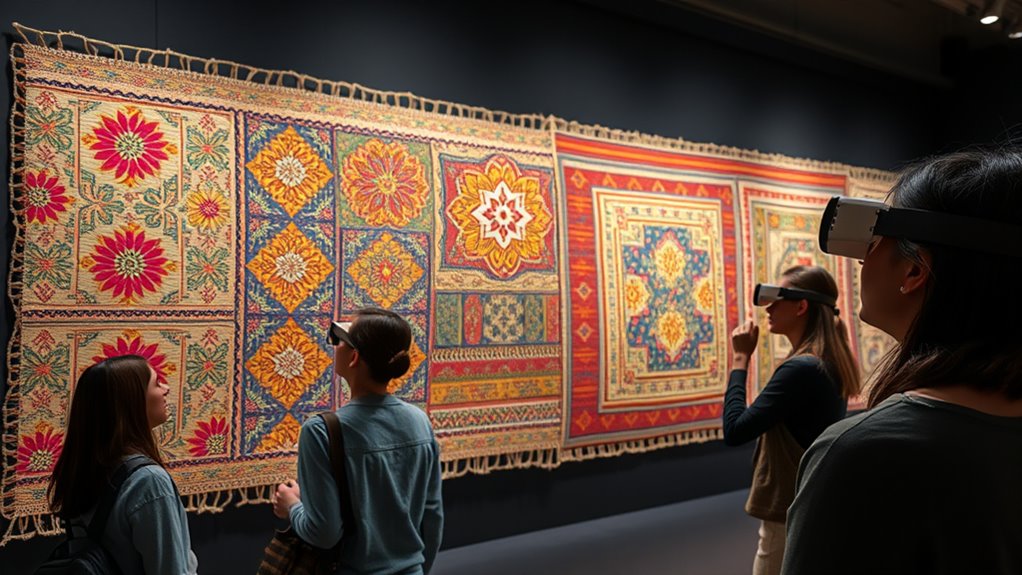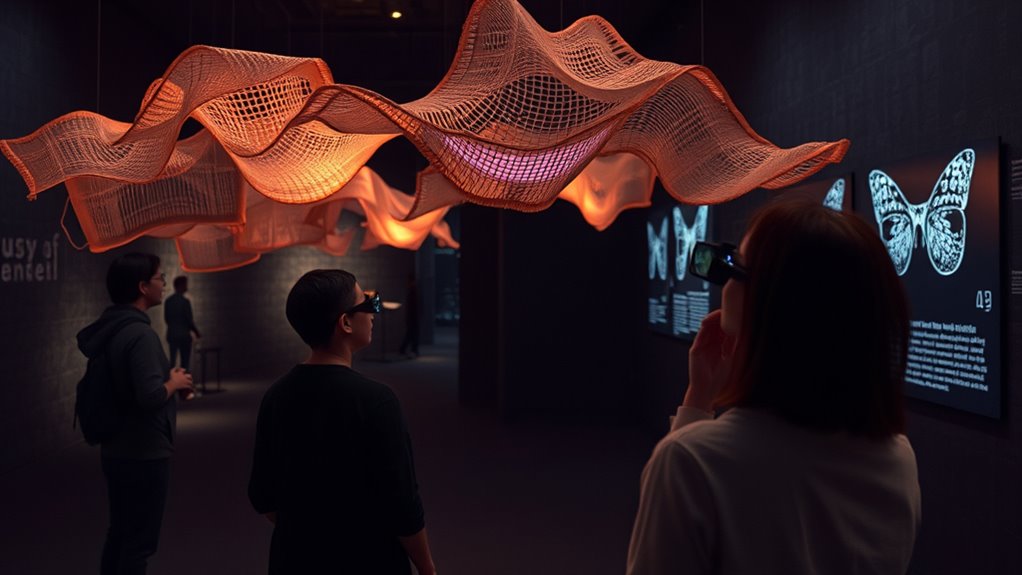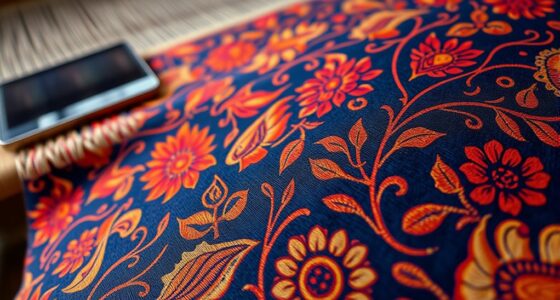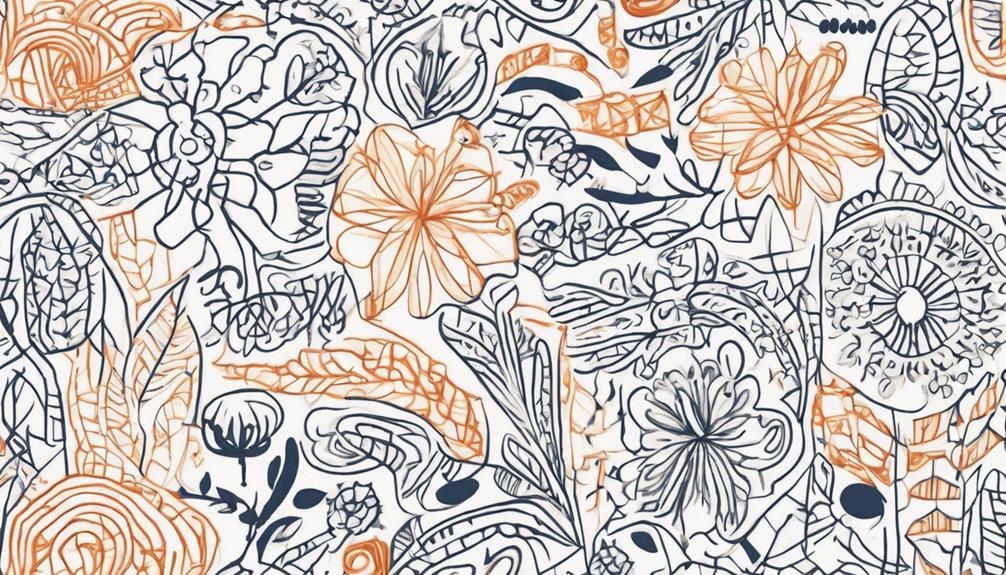Augmented reality is transforming how you experience textile stories in museums. It replaces static displays with immersive, interactive features that bring fabrics and their histories to life. You can explore virtual weaves, zoom into stitches, and hear narrations that deepen your understanding of cultural craftsmanship. This innovative approach makes textile artifacts more engaging, educational, and memorable. Keep exploring to discover how these next-gen exhibits are redefining museum storytelling and visitor experiences.
Key Takeaways
- AR enhances textile exhibits by transforming static displays into immersive, interactive storytelling experiences that deepen cultural understanding.
- Digital weaving tools in AR allow visitors to explore traditional and contemporary textile techniques virtually.
- Interactive features like zooming, animations, and storytelling touchpoints foster hands-on engagement and personalized learning.
- Multimedia integration, including audio, video, and 3D models, enriches narratives and contextualizes textile craftsmanship across eras.
- Next-gen museums leverage AR to make textile heritage more accessible, engaging, and meaningful for diverse audiences.

Augmented Reality (AR) is transforming how we experience textile stories by bringing fabrics and their histories to life in immersive ways. When you step into a modern AR exhibit, you’re not just seeing static displays; you’re engaging with dynamic, digital narratives that deepen your understanding of textiles’ cultural significance. One of the most exciting innovations in this space is digital weaving, where virtual threads and patterns are created in real-time, allowing you to witness the intricate craftsmanship behind each textile piece. These digital reconstructions enable you to explore traditional weaving techniques or experiment with contemporary designs without physical limitations. The process makes the storytelling more interactive, giving you a sense of connection to the artisans and the heritage they represent. Notably, high critical acclaim and box office success for animated storytelling techniques have influenced how museums incorporate visual narratives to captivate audiences.
Interactive displays form the backbone of these AR exhibits, inviting you to become part of the story. Instead of passively observing fabric exhibits, you can manipulate virtual textiles, zoom in to see detailed stitches, or watch how specific patterns evolve over time. This level of engagement transforms the museum experience into a hands-on journey that’s both educational and memorable. For example, you might point your device at a textile fragment and see an animated reconstruction of its original form, complete with explanations of the cultural context behind its motifs. These displays often incorporate touchpoints that reveal stories about the materials used, the techniques employed, or the symbolism embedded within the designs, making history feel immediate and personal.
AR also allows for seamless integration of multimedia elements, such as audio narrations, videos, and 3D models, which enrich the storytelling. As you explore a textile’s journey—from raw fiber to finished fabric—you’re transported into different eras and regions, gaining insights that traditional exhibits might not offer. Digital weaving in particular enables curators to showcase how textiles were created across different cultures and time periods, highlighting the diversity and innovation within textile arts. Meanwhile, interactive displays encourage you to participate actively, whether by designing your own virtual fabric or by unraveling the story behind a centuries-old textile pattern.
In the next generation of museums, this combination of AR, digital weaving, and interactive displays isn’t just about viewing artifacts—it’s about experiencing them. You get to see the craftsmanship, understand the cultural stories, and even contribute your own interpretations, making textile storytelling more accessible, engaging, and meaningful than ever before. The integration of innovative storytelling techniques ensures that these exhibits resonate with diverse audiences and foster a deeper appreciation for textile heritage.
Frequently Asked Questions
How Do AR Exhibits Impact Visitor Engagement and Learning?
AR exhibits boost your engagement and learning by offering virtual immersion that transports you into different worlds. You actively explore exhibits, making the experience more memorable. Sensory engagement is heightened as you see, hear, and sometimes touch digital elements, deepening your understanding. This interactive approach keeps you curious and involved, making educational content more accessible and exciting. Overall, AR transforms traditional exhibits into dynamic, immersive learning environments.
What Technical Skills ARe Needed to Create Textile AR Storytelling?
Did you know that 78% of museum visitors find AR exhibits more engaging? To create textile AR storytelling, you need skills in AR development, including programming languages like Unity or Unreal Engine. Textile design knowledge helps you craft authentic visuals. You should also understand 3D modeling, animation, and UX design. Combining these skills allows you to develop immersive, accurate textile stories that captivate visitors and enhance their learning experience.
How Do AR Exhibits Preserve Traditional Textile Craftsmanship?
You can use AR exhibits to preserve traditional textile craftsmanship by showcasing fiber preservation techniques and highlighting cultural heritage. When you integrate interactive digital displays, visitors gain a deeper understanding of the craftsmanship, ensuring these skills are remembered and valued. By combining technology with tradition, you help protect and celebrate cultural heritage, inspiring future generations to appreciate and maintain these time-honored textile practices.
What ARe Cost Considerations for Implementing Textile AR Exhibits?
Imagine a Victorian workshop, but today, your AR exhibit costs include budget planning and hardware expenses. You need to account for high-quality AR devices, maintenance, and software development. These costs can add up quickly, so you must carefully plan to avoid overspending. Balancing innovation with affordability is key. Focus on scalable solutions, seek sponsorships, and prioritize essential features to keep your textile storytelling project within budget.
How Can AR Storytelling Be Tailored for Diverse Audiences?
To tailor AR storytelling for diverse audiences, you should focus on cultural adaptation and accessibility enhancements. Incorporate multilingual options, culturally relevant content, and adjustable interfaces to engage varied groups effectively. Use clear visuals and audio descriptions to improve accessibility. By customizing experiences to meet different needs, you guarantee your AR exhibits resonate broadly, making the storytelling more inclusive and meaningful for everyone.
Conclusion
As you step into these augmented reality exhibits, you become part of a vibrant tapestry woven with history and innovation. AR transforms textiles into living stories, inviting you to explore their secrets like a curious explorer unearthing hidden treasures. This next-generation museum experience isn’t just a display; it’s a portal where threads of the past and future intertwine, creating a mesmerizing dance of technology and tradition that leaves you inspired and enthusiastic for more.










